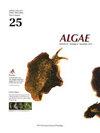Quantification of the ichthyotoxic raphidophyte Chattonella marina complex by applying a droplet digital PCR
IF 2.4
3区 生物学
Q1 MARINE & FRESHWATER BIOLOGY
引用次数: 2
Abstract
Quantifying the abundance of Chattonella species is necessary to effectively manage the threats from ichthyotoxic raphidophytes, which can cause large-scale mortality of aquacultured fish in temperate waters. The identification and cell counting of Chattonella species have been conducted primarily on living cells without fixation by light microscopy because routine fixatives do not retain their morphological features. Species belonging to the Chattonella marina complex, including C. marina and C. marina var. ovata, had high genetic similarities and the lack of clear morphological delimitations between the species. To estimate the abundance of C. marina complex in marine plankton samples, we developed a protocol based on the droplet digital polymerase chain reaction (ddPCR) assay, with C. marina complex-specific primers targeting the internal transcribed spacer (ITS) region of the rDNA. Cell abundance of the C. marina complex can be determined using the ITS copy number per cell, ranging from 25 ± 1 for C. marina to 112 ± 7 for C. marina var. ovata. There were no significant differences in ITS copies estimated by the ddPCR assay between environmental DNA samples from various localities spiked with the same number of cells of culture strains. This approach can be employed to improve the monitoring efficiency of various marine protists and to support the implementation of management for harmful algal blooms, which are difficult to analyze using microscopy alone.应用微滴数字PCR定量鱼毒性沙通菌码头复合体
对chatonella物种的丰度进行量化是有效管理鱼毒性raphidophytes威胁的必要条件,鱼毒性raphidophytes可导致温带水域养殖鱼类的大规模死亡。查顿菌的鉴定和细胞计数主要是在没有固定的活细胞上进行的,因为常规固定物不能保留其形态特征。chatattonella marina复合体所属物种(包括C. marina和C. marina var. ovata)具有较高的遗传相似性,但物种间缺乏明确的形态划分。为了估计海洋浮游生物样本中C. marina复合物的丰度,我们开发了一种基于液滴数字聚合酶链反应(ddPCR)测定的方案,使用C. marina复合物特异性引物靶向rDNA的内部转录间隔区(ITS)区域。C. marina复合物的细胞丰度可以通过每个细胞的ITS拷贝数来确定,范围从C. marina的25±1到C. marina var. ovata的112±7。在不同地点的环境DNA样本中加入相同数量的培养菌株,用ddPCR方法估计ITS拷贝数无显著差异。该方法可以提高对各种海洋原生生物的监测效率,并支持实施有害藻华的管理,这些有害藻华很难单独使用显微镜进行分析。
本文章由计算机程序翻译,如有差异,请以英文原文为准。
求助全文
约1分钟内获得全文
求助全文
来源期刊

Algae
PLANT SCIENCES-
CiteScore
5.10
自引率
25.00%
发文量
18
期刊介绍:
ALGAE is published by the Korean Society of Phycology and provides prompt publication of original works on phycology. ALGAE publishes articles on all aspects of phylogenetics and taxonomy, ecology and population biology, physiology and biochemistry, cell and molecular biology, and biotechnology and applied phycology. Checklists or equivalent manu-scripts may be considered for publication only if they contribute original information on taxonomy (e.g., new combinations), ecology or biogeography of more than just local relevance. Contributions may take the form of Original Research Articles, Research Notes, Review Articles and Book Reviews.
 求助内容:
求助内容: 应助结果提醒方式:
应助结果提醒方式:


